Due to relative inactivity and anatomical features, osteochondrosis rarely affects the chest area, but this disease cannot be called rare. Therefore, if you feel stiffness and pain in the scapula area, it is worth knowing what thoracic osteochondrosis is, its symptoms and treatment.
In fact, this disease is rarely limited to this part of the spine, but it can bring unpleasant consequences and feelings, no less than damage to the neck and waist. Its particularity can be safely called the "vagueness" of symptoms, even experienced doctors will be confused at the beginning of the disease.
What is thoracic osteochondrosis?
Osteochondrosis-Degenerative dystrophy of the intervertebral disc between the vertebrae and the vertebrae themselves.
As mentioned earlier, due to the following characteristics, the performance of this disease in the chest area is much lower than that of the lumbar or cervical spine:
- Inactivity in the chest area;
- It is well fixed by the ribs and the whole chest;
- Due to the kyphosis in the thoracic spine region (that is, the physiological curvature of the back of the spine), the vertebrae bear the greatest pressure at the front and are more durable.
But, unfortunately, everyone can get sick, especially if there are prerequisites.
What does the MRI of the thoracic spine show?
The diagnosis of diseases formed in the chest area must be done in a comprehensive manner, and MRI can show the true situation better than most studies.
How is MRI performed?
Everything is simple and painless-you need to lie on a bench, the bench enters a special spherical room, and wait for the allotted time until the device "illuminates" the body. It is worth removing all metal objects in advance and warning the staff to prevent foreign objects such as pacemakers and prostheses in the body.
Generally speaking, osteochondrosis was previously diagnosed entirely with the help of palpation-they explored the vertebrae, and there was pain, which meant that there was osteochondrosis. Now, doctors supplement their knowledge through special research. The most informative one is MRI, which can establish degenerative phenomena in cartilage and vertebrae to determine the existence of hernias and the characteristics of their development.
If you are not afraid of confined spaces, you can even take a nap.
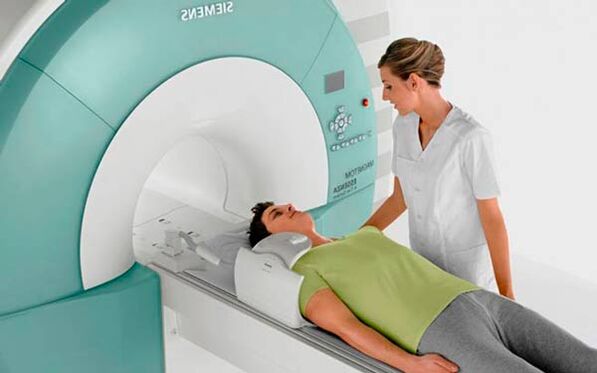
Symptoms of thoracic osteochondrosis
The symptoms of occult osteochondrosis in the chest area can be successfully hidden for a long time without showing up, and without causing pain or even discomfort. Later, when the damage has caused obvious manifestations, it is sometimes difficult to determine the source of the pain-they can be to the heart, internal organs, and legs. Therefore, it is necessary to analyze this issue in detail.
Therefore, doctors distinguish between several types of symptoms.
Reflexes are directly related to the negative effects of diseases on various receptors.
As a result, the patient felt:
- Pain in the scapula area or directly below, often "like a hoop" around and squeezed
- The focus of pain can be located in different parts of the body-the sternum, which simulates a heart attack, on the right side, disguised as the liver, or even at the waist, such as renal colic. Therefore, it is often necessary to conduct a comprehensive examination of the internal organs at the time of diagnosis. It can be concluded that there is a problem with the back.
Compression symptoms due to squeezing or stretching of nerve roots,
Therefore, it may appear:
- With weak legs, they seem to refuse;
- Loss of sensitivity in limbs;
- Numbness in the squeezed area, "goose bumps" feeling;
- A coma in the chest;
- You can find the tension of the surrounding muscles during massage;
- Organ work has deteriorated. Fortunately, this kind of neglect is rare.
In view of the particularity of women's physiology, sometimes the symptoms of thoracic osteochondrosis can be confused with other diseases.
Usually, the pain radiates to the breast, which makes women unconsciously think about their breast problems.
Drawing, the pain that often occurs is similar to fibrosis, tumors and other gland problems, which will make you go to the breast department for consultation. If the doctor does not find any abnormalities in the structure and function of the breast after examinations, examinations, and mammograms, it is safe to assume that there is osteochondrosis.
Causes of thoracic osteochondrosis
The causes of osteochondrosis in the chest and other areas are the same, but to accurately locate the problem here, clear prerequisites are required:
- Curvature of the spine, especially in the thoracic spine area;
- The existence of bad habits;
- wear high heel shoes;
- Being in an unnatural position for a long time, such as in front of a computer, in front of a sewing machine, or weeding in a garden;
- A lot of physical activity;
- Genetic susceptibility to back diseases;
- Pregnancy causes a shift in center of gravity;
- Flat feet and refusing to wear special orthopedic insoles;
- Spinal injury.

Signs of osteochondrosis in the sternal area
The signs of osteochondrosis in the chest area are pain, stiffness, and muscle tension in the area. As we have determined, there is a difference between reflex syndrome and compression syndrome, and the former needs to be discussed in more detail.
Backache and backache
The most obvious reflex syndromes of this disease are back pain and back pain. what is it?
Dorsago-Spine cutting, severe, severe pain, as if someone had inserted a knife into the back. Sometimes the pain can spread to the heart or breastbone.
It feels so "rainbow" that the patient is afraid to do anything, even take a deep breath. On palpation, you can notice muscle tension near the spine. In most cases, seizures occur after sitting in an uncomfortable position for a long time and undergoing drastic changes. Due to the severity of the pain and its positioning in the chest, the back is often mistaken for a heart attack, but the removed ECG makes the picture clearer.
Back pain is a kind of gradual pain that covers the chest, back and chest, and increases with exercise, especially when tilting and turning the body, even when sneezing or riding on bumps.
Unpleasantly, it is sometimes difficult to identify the most painful areas-these are superficial or deep tissues, back or chest, which complicates the establishment of a correct diagnosis.
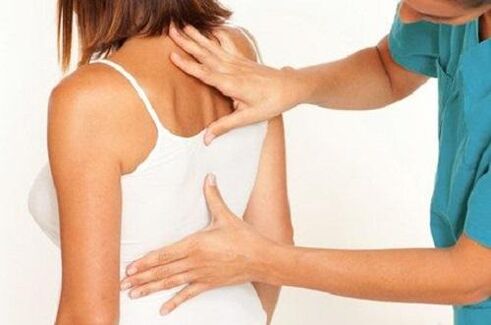
What is intercostal neuralgia?
Sometimes pain is felt in the intercostal space, then this symptom is called intercostal neuralgia. The characteristics of this symptom are:
- Severe pain, covering the intercostal space, sometimes radiating to the lower back, arms or shoulder blades, lasting for hours or even days;
- Soreness when probing the ribs;
- The skin at the focal point of inflammation is red or pale, with a burning sensation, and vice versa, numbness;
- Inability to breathe evenly and deeply-every breath brings torture;
- Some muscles in the chest or back twitch spontaneously.
How to treat intercostal neuralgia at home
Before treating intercostal neuralgia, you need to confirm the diagnosis correctly, because its symptoms are similar to heart disease. If you start to struggle with real myocardial problems at home, you may encounter big problems.
If this is not the first episode and the doctor confirms the diagnosis, you can turn to home treatments, the most important of which are:
- Rest in bed for 2-3 days;
- Take sedatives to relieve pain and relieve cramps;
- Use topical analgesics in gels and ointments;
- Use warming agents-mustard plaster and pepper plaster;
- Restoring nerve tissue by taking vitamin B;
- To fix the spine, a corset is used for this purpose to keep the body in the correct position and reduce the compression of the vertebrae.
Back pain can indeed go away within a few days, but in order to avoid recurrence, you must fight the cause for several months.
Atypical symptoms of breast osteochondrosis
In addition to clinical manifestations, thoracic osteochondrosis can have completely atypical signs and can easily be confused with other diseases. Among them:
- Imitating women’s heart or chest pain, the discomfort will be tortured for several weeks, but additional examinations did not find heart and chest problems;
- The location of pain in the iliac area, such as gastritis or colitis, or the right side, such as liver dysfunction, due to the failure of nerve impulse conduction and deterioration of digestive function, the diagnosis becomes complicated, and it is difficult to determine the primacy here;
- Urination and erectile function are interrupted, which also occurs due to the failure of nerve endings.
But there is a clue-closer to the night, because the back nerves are compressed, it will increase every hour after waking up, and will pass after a rest, and the work of the heart or other internal organs will be disturbed. It is obvious throughout the day.
How to treat thoracic osteochondrosis?
The treatment of thoracic osteochondrosis is a long-term affair, and it is impossible to restore the tissues, but can only slow down the process and prevent it from becoming worse. But this does not mean that you can calm down, reconcile, do nothing, and realize that hard work is futile, because treatment will give you the opportunity to live and work fully, and the neglected form will not end in a fatal way. But they can severely destroy life.
medical treatement
At the first symptoms of osteochondrosis, medical treatment involves the use of pain-relieving drugs, for which it is best to take non-steroidal anti-inflammatory drugs.
They are prescribed for 1-2 weeks, during which time the pain usually disappears.
You can combine the pills, capsules or suppositories you take with topical analgesics or compresses (although they can cause allergies, so you need to drop them on a small area of the skin and wait for half an hour before use), similar ointments are also suitable.
Sometimes, with the strong pain, anti-inflammatory drugs can't do anything, so analgesics in the form of droppers are omitted.
In some cases, you must inject painkillers along the spine. This procedure is called a paravertebral block and is performed by a doctor in the hospital.
Later, muscle relaxants were used to relax muscles, diuretics were prescribed to combat edema around nerve endings, and blood circulation and tissue regeneration were restored as a trophy. In the future, in order to prevent recurrence, you will have to drink cartilage protectants for several months.
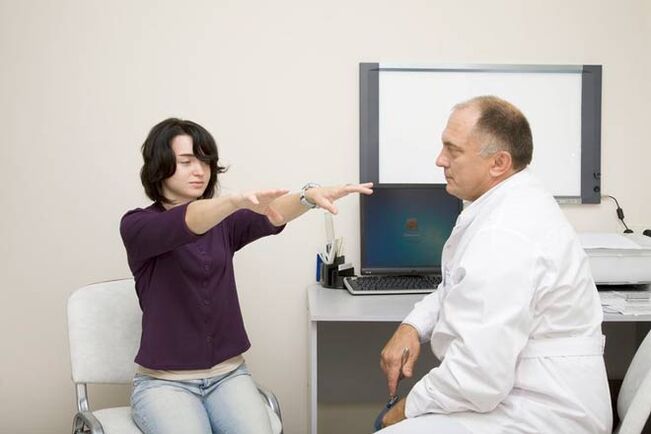
Family therapy
At home, you can use many non-drug methods to treat osteochondrosis. They are:
- massage;
- Exercise therapy
- Stretching exercises;
- Compression and infusion to normalize the metabolism in the vertebrae.
As for the last point, here you can suggest such folk remedies:
- Rub with calendula tincture. For this, take 200 grams of vodka, triple alcohol and camphor alcohol for every 100 grams of flower for 14 days. Rub the affected area before going to bed and wrap it in a warm scarf;
- Mix equal amounts of orange peel and lemon balm, pour into a cup of boiling water, let stand for one hour, filter, and add 1 teaspoon each. Valerian and honey tincture, drink ½ cup a day for one month.
Exercises in the chest area
Perhaps the exercise for thoracic osteochondrosis is the most effective in preventing subsequent complications.
Gymnastics can relieve stiffness, relax muscles, strengthen muscles, and increase one's physical activity. Continuous and regular training can speed up blood circulation, eliminate inflammation of nerve roots, and reduce pressure on the spine. This exercise therapy is not only suitable for thoracic spine injuries, but also for any part of the spine.
However, doctors do not recommend such exercises in cases of severe deterioration, poor health, coordination problems, high blood pressure, and arrhythmia.
It is best to take a bath before training, massage and warm up to stretch the muscles.
So, the best practice:
- Lift your shoulders 10 times in sequence;
- Turn your head to the sides and freeze for a few seconds at the extreme point;
- Place your hands under your shoulder blades, bend over and freeze for 10 seconds;
- Stand, bend to one side, touch your knees with your shoulders, and repeat in the other direction;
- Lie on the floor, place a roller under the thoracic spine, put your hands behind your head, raise your shoulders, and then raise the roller a little bit. This action is to stretch the spine;
- Lie on your stomach and raise your chest above the floor. First stretch your arms forward, then stretch your arms to both sides, and finally connect your back into a lock.
This kind of charging helps to forget months of back problems.
massage
Massage of chest osteochondrosis helps relieve pain, improve blood circulation and lymphatic drainage, relieve muscle spasms, improve muscle tone, and enhance the nutrition of intervertebral cartilage.
Usually, the course does not start immediately on the first day, but after 3-4 days, when the main unpleasant feeling has disappeared, in rare cases, the masseur can help during the deterioration period.
The first treatment must be gentle, do not put too much pressure on the tissue; skilled hands and special massage machines are suitable as tools. Without proper experience and education, massage is not worthwhile-you will only exacerbate the problem, so don't skimp on professional courses.
Manual therapy
At first glance, manual therapy is similar to massage-it is also touched with hands, but in fact, chiropractors are different from massage therapists. It does not act on the muscles and skin, but on the vertebra itself, which requires moreStrength and skill.
It uses percussive techniques, alternating tension and relaxation of muscles, flexion of the spine to eliminate obstacles in the spine structure, and instrumental methods for treating elderly patients.
Manipulative therapists can improve the tension of the back muscles, restore the mobility of the spine, correct the curvature and prolapse of the vertebrae, and improve blood circulation.
Prevention is the best treatment
In order to prevent the occurrence of this unpleasant disease, you will have to make an effort, but it is worth it. Respected:
- Monitor your weight, because the extra kilogram is an extra burden on the spine;
- Eat well and have a wide variety;
- Avoid hypothermia of the spine;
- Swimming is perfect for sports activities, especially for sedentary work;
- Rest and warm up at work (some exercises in the above complex are OK);
- Change posture in front of the computer for a long time, a table;
- Avoid excessive pressure on the spine.

Nutrition adjustment
The condition of joints, blood vessels, and bones depends directly on nutrition. If symptoms of osteochondrosis occur, it is worth correcting. Therefore, it is worth excluding:
- Bacon that clogs the body;
- Deep frying, leading to weight gain;
- Sweet;
- Soda water is very sweet.
Instead, go to:
- Boiled meat and broth of pork, chicken and rabbit meat;
- vegetables;
- vegetables;
- Dairy products, especially kefir, cheese and cottage cheese;
- Cook the fish at least once a week;
- Fruits, apples are better.
Correct posture in dreams
Even in a dream, osteochondrosis of the chest has its own rules, and you need to choose the most correct posture. You will have to give up your favorite abdominal rest-in this position, the head is tilted back and the blood vessels are compressed, impairing blood circulation in the brain.
The best disease posture is:
- On the side, when all organs and limbs are at rest and uncompressed;
- at the back;
- The legs in the fetal position were pulled to the chest, and the muscles of the back were relaxed in it.
I noticed that the bed must also be paid attention to. It should have a firm base, a rigid orthopedic mattress and a small pillow, with only the head and no shoulders on it, supporting it at the level of the body. We will have to say goodbye to our favorite soft mattresses and huge feather pillows.
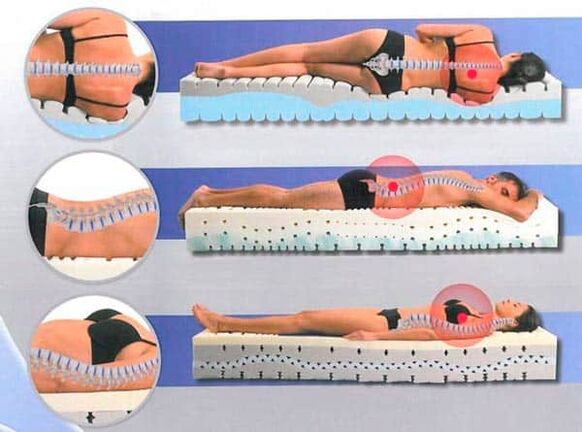
Sitting posture
Even sitting with chronic osteochondrosis should be correct! Tips that must be strictly followed:
- Avoid using upholstered furniture;
- Choose a chair so that the legs reach the floor and the depth is 2/3 of the thigh;
- There should be a lot of space under the table when sitting, so you don’t have to bend your legs;
- Sit for a long time every 10-15 minutes, change posture, warm up, walk;
- Ensure that the backrest rests on the backrest;
- Do not bend forward to avoid muscle strain;
- When driving, place a roller under the waist to maintain physical curvature;
- Even if you relax on the sofa or bed, change your posture every hour to relax your back muscles and stretch.
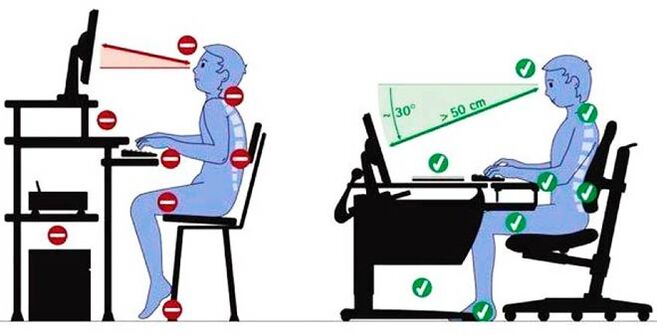
Osteochondrosis is not fatal, but a very unpleasant disease that must be controlled from its initial manifestations. Now you know what to look for, how to recognize it through multiple symptoms, how to exercise and overcome osteochondrosis. Bold and healthy!



































